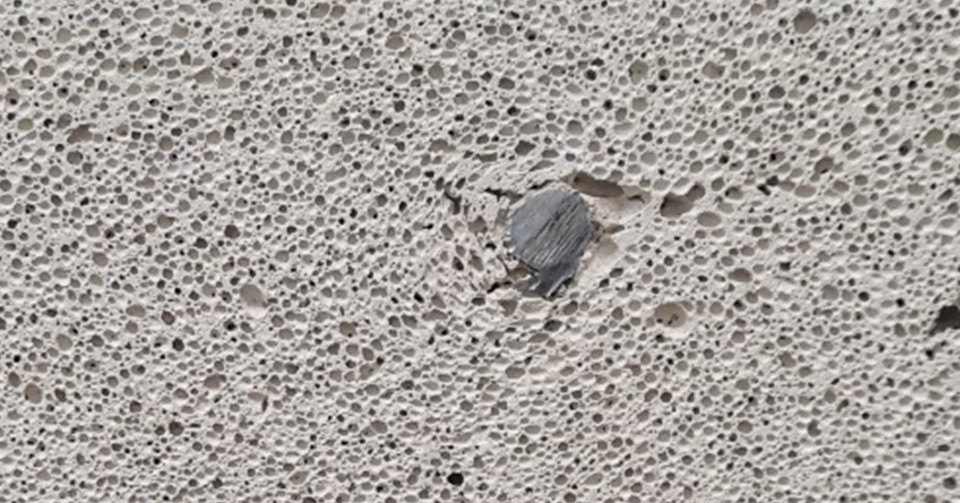Calls grow for RAAC social housing inspection programme

A close-up of reinforced autoclaved aerated concrete (RAAC)
The lightweight form of concrete linked to the collapse of the roof at a primary school in 2018 could be widespread in social homes built during the 1950s-70s, consultants have warned.
Yesterday Scottish Construction Now reported that reinforced autoclaved aerated concrete (RAAC) was found in at least 35 schools across the country, leading the Scottish Government to conduct reviews to fully understand the presence of the potentially dangerous material.
This comes after NHS Scotland issued a Safety Action Notice which warned that RAAC could be present in more than 250 of its buildings. The notice said roofs, walls and flooring made of RAAC were at “risk of catastrophic structural failure”, which could occur “suddenly” and “without warning”.
While the First Minister has said schools in Scotland will remain open during any required remediation works, the Department for Education has ordered the closure of 104 schools in England over fears buildings are at risk of collapse.
Now calls are growing for social housing landlords to embark on an urgent programme of inspections in order to establish whether their stock contains the material.
Law firm Winckworth Sherwood said housing associations should “urgently check” building specifications and drawings for the use of RAAC, and commission “immediate structural surveys” where it is found.
Greg Carter, legal director and construction specialist at the firm, said: “RAAC was widely used in the construction of social housing between the 1950s and 1990s and, just as in school buildings and other structures, presents a serious risk for housing associations and their residents.
“Where social housing providers have not already done so, they should urgently check as-built drawings and specifications and if RAAC is found to have been used commission structural surveys to verify its condition and any remedial works.
“Unlike schools, no nationwide survey of social housing has been conducted and the extent of the problem is unknown. Thorough checks of housing stock will be the only way to fully understand the size and scale of any problems.”
“Where RAAC is discovered and is defective, social housing providers may be able to claim the cost of remedial work on building or other insurance policies.”
Mr Carter added: “However, depending on the scale of the problem, and as seen following the Grenfell tragedy, insurers may opt to exclude RAAC claims. That would be disappointing and frustrating for housing providers and tenants.
“But social housing providers should not need reminding that they have a legal responsibility to manage their buildings, to meet repair and maintenance obligations and meet relevant health and safety regulations. Inaction is not an option.”
Building surveyor Rapleys have told Housing Today that work it has done surveying the public estate as a whole suggested that as many as one in 10 public buildings from the period contained RAAC panels.
Richard Crow, a partner with the housing consultancy firm Rapleys, told the site: “It’s really a question of how many properties were built during the 1950s, 60s and 70s – as the manufacture and design of the panels during this period was inefficient and inadequate, with steel reinforcement also installed in the wrong place.
“This was further compounded by years of poor maintenance and water ingress from failed roof coverings, causing further deterioration.
“The attributing issues from these periods of construction, that compounds the current lack of certainty on how far the problem extends, is that health and safety and operational and maintenance [manuals] did not exist in any form, let alone to the standards of our current construction industry.
“Therefore, there is no way to say which properties have Raac other than to inspect properties containing flat roofs, built during the 50s, 60s and 70s.
“During this period, the largest number of social housing was built so it will be a case of urgent thorough inspection across the country by local authorities, and then, for those that do have it (our figures of 5-10% were based on the investigations we are working on within schools), putting in place the solutions to ensure they are protected against damage.”
Reinforced autoclaved aerated concrete was used to build roofs, walls and floors from the 1960s to the 1990s. It was widely used in public buildings and has been found in Scottish hospitals, schools and police stations. It is recognised that RAAC panels have material and construction deficiencies making them less robust than traditional concrete and is considered in industry terms ‘a latent defect’.
The concrete is being assessed after it was linked to the collapse of the roof at Singlewell Primary School in Kent in 2018.
Colin Tait, a civil and structural director at Harley Haddow, said potential RAAC panel failures could be catastrophic.
Mr Tait said: “It is surprising that this has suddenly become an issue, as the failure mechanisms of RAAC panels have long been discussed and on the radar of structural engineers. Across the UK, RAAC panels are present in a large number of buildings from police stations through to schools and hospitals. A collapse of these planks could be catastrophic, which is why we are seeing such rapid action being taken.
“From the mid-90s, the UK’s Building Research Establishment was publishing information guides on RAAC identification, potential failure modes, maintenance regimes and remedial works – this was all off the back of RAAC failures in the 80s.
“As recently as 2019, warnings by the UK’s SCOSS (Standing Committee for Structural Safety) of a RAAC panel collapse in a school brought a renewed light to the subject. Respective government bodies made building owners aware of these potential risks at that time.
“There are many reasons why these planks fail. Overloading, poor or limited plank support, excessive deflection and water ingress to name a few. Some of these flaws are down to poor design, poor construction, or simply down to poor maintenance. Cracking to the plank, particularly near its support and water ingress – whereby it turns the concrete, in essence, to a ‘sponge’ – were felt particularly worrying. Hidden behind false ceilings, collapse of these planks could be without warning and devastating.
“Presently the Department for Education August 2023 guidance advises restriction of access to spaces where RAAC has been confirmed. This is irrespective of the condition, the maintenance programme or inspection regime previously implemented.”
A Scottish Government spokesperson said: “Building safety is an issue the Scottish Government takes very seriously and we are fully aware of significant issues with some Raac.
“Reviews of Raac have been conducted by local authorities, NHS Scotland and other public sector organisations for some time so we can all fully understand the scope of Raac, including in social housing.
“In addition, we established a cross-sector working group on Raac to ensure action is taken where required so that people are safe and feel safe in buildings.”






















